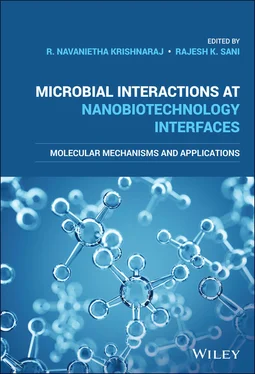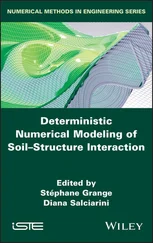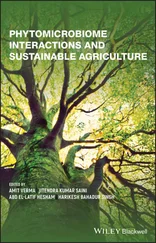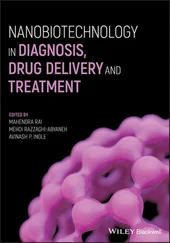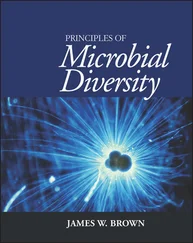Microbial Interactions at Nanobiotechnology Interfaces
Здесь есть возможность читать онлайн «Microbial Interactions at Nanobiotechnology Interfaces» — ознакомительный отрывок электронной книги совершенно бесплатно, а после прочтения отрывка купить полную версию. В некоторых случаях можно слушать аудио, скачать через торрент в формате fb2 и присутствует краткое содержание. Жанр: unrecognised, на английском языке. Описание произведения, (предисловие) а так же отзывы посетителей доступны на портале библиотеки ЛибКат.
- Название:Microbial Interactions at Nanobiotechnology Interfaces
- Автор:
- Жанр:
- Год:неизвестен
- ISBN:нет данных
- Рейтинг книги:4 / 5. Голосов: 1
-
Избранное:Добавить в избранное
- Отзывы:
-
Ваша оценка:
- 80
- 1
- 2
- 3
- 4
- 5
Microbial Interactions at Nanobiotechnology Interfaces: краткое содержание, описание и аннотация
Предлагаем к чтению аннотацию, описание, краткое содержание или предисловие (зависит от того, что написал сам автор книги «Microbial Interactions at Nanobiotechnology Interfaces»). Если вы не нашли необходимую информацию о книге — напишите в комментариях, мы постараемся отыскать её.
Microbial Interactions at Nanobiotechnology Interfaces — читать онлайн ознакомительный отрывок
Ниже представлен текст книги, разбитый по страницам. Система сохранения места последней прочитанной страницы, позволяет с удобством читать онлайн бесплатно книгу «Microbial Interactions at Nanobiotechnology Interfaces», без необходимости каждый раз заново искать на чём Вы остановились. Поставьте закладку, и сможете в любой момент перейти на страницу, на которой закончили чтение.
Интервал:
Закладка:
77 Lin, C.‐C., Yeh, Y.‐C., Yang, C.‐Y., Chen, C.‐L., Chen, G.‐F., Chen, C.‐C., & Wu, Y.‐C. (2002). Selective binding of mannose‐encapsulated gold nanoparticles to type 1 pili in Escherichia coli. Journal of the American Chemical Society, 124(14), 3508–3509.
78 Liu, J., Chen, D., Peters, B. M., Li, L., Li, B., Xu, Z., & Shirliff, M. E. (2016). Staphylococcal chromosomal cassettes mec (SCCmec): A mobile genetic element in methicillin‐resistant Staphylococcus aureus. Microbial Pathogenesis, 101, 56–67.
79 Liu, J.‐L., Zhang, W.‐J., Li, X.‐D., Yang, N., Pan, W.‐S., Kong, J., & Zhang, J.‐S. (2016). Sustained‐release genistein from nanostructured lipid carrier suppresses human lens epithelial cell growth. International Journal of Ophthalmology, 9(5), 643.
80 Liu, S., Zeng, T. H., Hofmann, M., Burcombe, E., Wei, J., Jiang, R., … Chen, Y. (2011). Antibacterial activity of graphite, graphite oxide, graphene oxide, and reduced graphene oxide: Membrane and oxidative stress. ACS Nano, 5(9), 6971–6980.
81 Liu, Y., Tee, J. K., & Chiu, G. N. C. (2015). Dendrimers in oral drug delivery application: Current explorations, toxicity issues and strategies for improvement. Current Pharmaceutical Design, 21(19), 2629–2642.
82 Luckarift, H. R., Balasubramanian, S., Paliwal, S., Johnson, G. R., & Simonian, A. L. (2007). Enzyme‐encapsulated silica monolayers for rapid functionalization of a gold surface. Colloids and Surfaces B: Biointerfaces, 58(1), 28–33.
83 Machado, S., Pacheco, J., Nouws, H., Albergaria, J. T., & Delerue‐Matos, C. (2015). Characterization of green zero‐valent iron nanoparticles produced with tree leaf extracts. Science of the Total Environment, 533, 76–81.
84 Markowska‐Szczupak, A., Ulfig, K., & Morawski, A. (2011). The application of titanium dioxide for deactivation of bioparticulates: An overview. Catalysis Today, 169(1), 249–257.
85 Martinez, J. (2018). Ecology and evolution of chromosomal gene transfer between environmental microorganisms and pathogens. Microbiology Spectrum, 6(1), 1–16.
86 Mazille, F., Moncayo‐Lasso, A., Spuhler, D., Serra, A., Peral, J., Benítez, N., & Pulgarin, C. (2010). Comparative evaluation of polymer surface functionalization techniques before iron oxide deposition. Activity of the iron oxide‐coated polymer films in the photo‐assisted degradation of organic pollutants and inactivation of bacteria. Chemical Engineering Journal, 160(1), 176–184.
87 Miller, W. R., Munita, J. M., & Arias, C. A. (2014). Mechanisms of antibiotic resistance in Enterococci. Expert Review of Anti‐infective Therapy, 12(10), 1221–1236.
88 Miola, M., Fucale, G., Maina, G., & Verné, E. (2015). Antibacterial and bioactive composite bone cements containing surface silver‐doped glass particles. Biomedical Materials, 10(5), 055014.
89 Mokerov, V., Fedorov, Y. V., Velikovski, L., & Scherbakova, M. Y. (2001). New quantum dot transistor. Nanotechnology, 12(4), 552.
90 Morones, J. R., Elechiguerra, J. L., Camacho, A., Holt, K., Kouri, J. B., Ramírez, J. T., & Yacaman, M. J. (2005). The bactericidal effect of silver nanoparticles. Nanotechnology, 16(10), 2346.
91 Mukherjee, A., Mohammed Sadiq, I., Prathna, T., & Chandrasekaran, N. (2011). Antimicrobial activity of aluminium oxide nanoparticles for potential clinical applications. Science Against Microbial Pathogens: Communicating Current Research and Technological Advances, 1, 245–251.
92 Mulvaney, P. (1996). Surface plasmon spectroscopy of nanosized metal particles. Langmuir, 12(3), 788–800.
93 Narayanan, R., & El‐Sayed, M. A. (2004). Shape‐dependent catalytic activity of platinum nanoparticles in colloidal solution. Nano Letters, 4(7), 1343–1348.
94 Nel, A. E., Mädler, L., Velegol, D., Xia, T., Hoek, E. M., Somasundaran, P., … Thompson, M. (2009). Understanding biophysicochemical interactions at the nano–bio interface. Nature Materials, 8(7), 543.
95 Neu, H. C. (1992). The crisis in antibiotic resistance. Science, 257(5073), 1064–1073.
96 Nikaido, H., & Takatsuka, Y. (2009). Mechanisms of RND multidrug efflux pumps. Biochimica et Biophysica Acta (BBA)‐Proteins and Proteomics, 1794(5), 769–781.
97 Ong, W. J., Tan, L. L., Chai, S. P., Yong, S. T., & Mohamed, A. R. (2014). Facet‐dependent photocatalytic properties of TiO2‐based composites for energy conversion and environmental remediation. ChemSusChem, 7(3), 690–719.
98 Oren, Z., Ramesh, J., Avrahami, D., Suryaprakash, N., Shai, Y., & Jelinek, R. (2002). Structures and mode of membrane interaction of a short α helical lytic peptide and its diastereomer determined by NMR, FTIR, and fluorescence spectroscopy. European Journal of Biochemistry, 269(16), 3869–3880.
99 Padmavathy, N., & Vijayaraghavan, R. (2008). Enhanced bioactivity of ZnO nanoparticles – An antimicrobial study. Science and Technology of Advanced Materials, 9(3), 035004.
100 Pal, S., Tak, Y. K., & Song, J. M. (2007). Does the antibacterial activity of silver nanoparticles depend on the shape of the nanoparticle? A study of the gram‐negative bacterium Escherichia coli. Applied and Environmental Microbiolog, 73(6), 1712–1720.
101 Pan, X., Wang, Y., Chen, Z., Pan, D., Cheng, Y., Liu, Z., … Guan, X. (2013). Investigation of antibacterial activity and related mechanism of a series of nano‐Mg(OH)2. ACS Applied Materials & Interfaces, 5(3), 1137–1142.
102 Peulen, T.‐O., & Wilkinson, K. J. (2011). Diffusion of nanoparticles in a biofilm. Environmental Science & Technology, 45(8), 3367–3373.
103 Pokropivny, V., & Skorokhod, V. (2007). Classification of nanostructures by dimensionality and concept of surface forms engineering in nanomaterial science. Materials Science and Engineering C, 27(5‐8), 990–993.
104 Prasannakumar, J., Vidya, Y., Anantharaju, K., Ramgopal, G., Nagabhushana, H., Sharma, S., … Rajanaik, H. (2015). Bio‐mediated route for the synthesis of shape tunable Y2O3: Tb3+ nanoparticles: Photoluminescence and antibacterial properties. Spectrochimica Acta Part A: Molecular and Biomolecular Spectroscopy, 151, 131–140.
105 Pumera, M. (2010). Graphene‐based nanomaterials and their electrochemistry. Chemical Society Reviews, 39(11), 4146–4157.
106 Qi, G., Li, L., Yu, F., & Wang, H. (2013). Vancomycin‐modified mesoporous silica nanoparticles for selective recognition and killing of pathogenic Gram‐positive bacteria over macrophage‐like cells. ACS Applied Materials & Interfaces, 5(21), 10874–10881.
107 Qi, L., Xu, Z., Jiang, X., Hu, C., & Zou, X. (2004). Preparation and antibacterial activity of chitosan nanoparticles. Carbohydrate Research, 339(16), 2693–2700.
108 Raffi, M., Mehrwan, S., Bhatti, T. M., Akhter, J. I., Hameed, A., Yawar, W., & ul Hasan, M. M. (2010). Investigations into the antibacterial behavior of copper nanoparticles against Escherichia coli. Annals of Microbiology, 60(1), 75–80.
109 Raghupathi, K. R., Koodali, R. T., & Manna, A. C. (2011). Size‐dependent bacterial growth inhibition and mechanism of antibacterial activity of zinc oxide nanoparticles. Langmuir, 27(7), 4020–4028.
110 Ramirez, M. S., & Tolmasky, M. E. (2010). Aminoglycoside modifying enzymes. Drug Resistance Updates, 13(6), 151–171.
111 Ramyadevi, J., Jeyasubramanian, K., Marikani, A., Rajakumar, G., & Rahuman, A. A. (2012). Synthesis and antimicrobial activity of copper nanoparticles. Materials Letters, 71, 114–116.
112 Ranghar, S., Sirohi, P., Verma, P., & Agarwal, V. (2014). Nanoparticle‐based drug delivery systems: Promising approaches against infections. Brazilian Archives of Biology and Technology, 57(2), 209–222.
113 Raza, M., Kanwal, Z., Rauf, A., Sabri, A., Riaz, S., & Naseem, S. (2016). Size‐and shape‐dependent antibacterial studies of silver nanoparticles synthesized by wet chemical routes. Nanomaterials, 6(4), 74.
Читать дальшеИнтервал:
Закладка:
Похожие книги на «Microbial Interactions at Nanobiotechnology Interfaces»
Представляем Вашему вниманию похожие книги на «Microbial Interactions at Nanobiotechnology Interfaces» списком для выбора. Мы отобрали схожую по названию и смыслу литературу в надежде предоставить читателям больше вариантов отыскать новые, интересные, ещё непрочитанные произведения.
Обсуждение, отзывы о книге «Microbial Interactions at Nanobiotechnology Interfaces» и просто собственные мнения читателей. Оставьте ваши комментарии, напишите, что Вы думаете о произведении, его смысле или главных героях. Укажите что конкретно понравилось, а что нет, и почему Вы так считаете.
